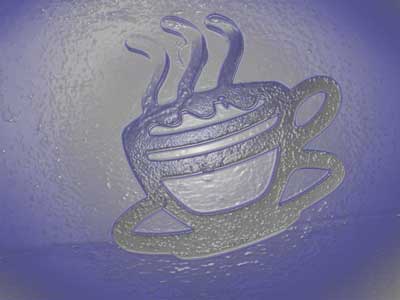Caffeine
Caffeine is an alkaloid. There are numerous alkaloids compounds, such as the methylxanthines, with three distinguished compounds: caffeine, theophylline, and theobromine. It is found in over 60 plants, such as cola nuts, coffee, tea, and cacao beans. While caffeine is part of the reasons people drink coffee, it plays virtually no role in its flavor.
Caffeine is a white powder which dissolves easily in water and has a slightly bitter taste. Much of the caffeine that is removed from coffee is sold to pharmaceutical and soft drink companies. For coffee to be called "decaffeinated," it must have at least 97% of its caffeine removed.
Removing Caffeine
There are two basic methods for removing the caffeine from green coffee beans:
- By chemicals - The most common chemical used is methylene chloride that clings to the caffeine molecule and is then flushed away. Virtually no traces of the chemical is left. Any chemical that is left behind is evaporated when the beans are roasted. This method produces a better tasting cup of coffee.
- Swiss water process - Repeated flushings with hot, high-pressure water and charcoal is used to wash away the caffeine. Some flavor of the coffee is lost using this method, but it is popular because it uses no chemicals. Since it uses no chemicals, it can get a Kosher rating.
NOTE: Thanks to Jesse R. Grenz, University of Minnesota, Dept. of Biochemistry, for the following information:
A new method was developed that is slightly more expensive. Liquefied carbon dioxide (really high pressure at a low temperature) is passed over the beans. This causes the caffeine to go into solution in the CO2. The beans are kept above the bottom of the chamber, so as when the pressure is released, the CO2 is released as gas (or sometimes forms a solid if not done correctly) and the caffeine precipitates in crystal form to the bottom of the chamber.
It was found that even the traces of methylene chloride used in the chemical decaffination process were harmful. Any chemicals left in this process are supposedly evaporated during the roasting process. This is true, for the most part. However, there can be some reactions between methylene chloride (CH2Cl2) and some of the materials in the bean itself. It probably doesn't pose too much of a problem, unless one drinks as much coffee as I do times about a thousand. Nevertheless, there were some complaints (but less than when carbon-tet was used for some food treatments). I'm not certain how often the liquid CO2 process is used in comparison to others, though.
Selected Caffeine Beverage Contents
Caffeine Content of Some Selected Beverages (varies depending on how prepared):
- NoDoz - 2 doses - 200 mg
- Coffee Drip - 5 oz - 110-150 mg
- Excedrin - 2 doses - 130 mg
- Jolt - 12 oz - 100.0 mg
- Anacin - 2 doses - 64 mg
- Coffee Perk - 5 oz - 60-125 mg
- Mountain Dew - 12 oz - 55.0 mg
- Tab - 12 oz - 46.8 mg
- Coca-Cola - 12 oz - 45.6 mg
- Coffee Instant - 5 oz - 40 - 105 mg
- Tea, 5 min. steep - 5 oz - 40-100 mg
- Dr. Pepper - 12 oz - 39.6 mg
- Pepsi Cola - 12 oz - 37.2 mg
- Espresso - 1 shot - 30-40 mg
- Tea, 3 min. steep - 5 oz - 20-50 mg
- Chocolate - 1 oz - 1-35 mg
- Decaf Coffee - 5 oz - 2-5 mg
- 7 Up - 12 oz - 0 mg

